
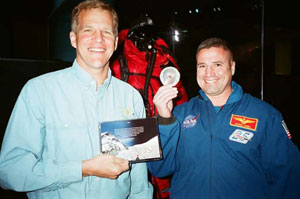 Duct Tape
Duct Tape+ Two Pringles lids
= Nugget Containment Device
Former NASA astronaut Scott Parazynski, M.D., left, and current astronaut George Zamka hold bits of Apollo 11 moon rock that Parazynski carried, on loan from NASA, to the top of Mt. Everest last spring. They also hold an Earth rock that he collected while on the summit. Specifically, Zamka holds the "Nugget Containment Device," two Pringles potato chip can lids sealed together with duct tape, which Parazynski used to secure the moon rock samples as he summited Everest on May 20, 2009.
Here we go again - more Duct Tape* fixes in space...
3/18/08 Space Station Gets Helping Hand (source Johnson Space Center, Houston)
Astronauts completed construction of the giant robot (Dextre) during an overnight spacewalk at the International Space Station. Dextre now has tools that any guy with a well-stocked tool bench would envy.
The 12-foot-tall robot received pan and tilt color cameras to serve as its eyes. It also got a pretty nifty tool holder assembly with an extension for socket wrenches, manipulators and an offset tool that will allow it to turn bolts that are too deeply set to be easily grasped.
Dextre is no plumber, which would have come in handy after a pipe under the floor of the Space Shuttle Endeavour's middeck sprung a slight leak.
Cmdr. Dominic Gorie's plumbing skills are being put to the test. To stop the leak, Gorie wrapped the pipe in towels held in place by duct tape.
7/11/06 Even in space, a little duct tape may work wonders. (source AP via CNN.com)
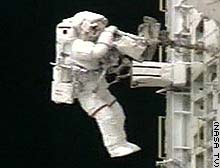 Astronaut Piers Sellers suggested using some multipurpose sticky material to fix a safety-jet backpack used during spacewalks after it almost came loose from him while he repaired the international space station.
Astronaut Piers Sellers suggested using some multipurpose sticky material to fix a safety-jet backpack used during spacewalks after it almost came loose from him while he repaired the international space station.
"Right now, is there some kind of tape fix that you guys could think about that would be helpful?" Sellers asked Mission Control Tuesday morning, a day after the propulsive backpack started to come loose during his spacewalk with astronaut Mike Fossum.
Fossum had to tether the device to Sellers to keep it from flying away.
The jet backpack, nicknamed SAFER, is worn by every astronaut during a spacewalk. It allows an astronaut to propel himself or herself to safety in an emergency, for instance if a tether or foot restraint holding the astronaut in place breaks.
The two connecting latches of Sellers' backpack attachment, designed to be used if an astronaut floats free, loosened at different times, but he was never in danger of losing it, NASA officials said.
The spacewalkers hope they can use *Kapton tape to hold the backpack latches in place when they make their next spacewalk on Wednesday. The tape is like duct tape but slippery and able to withstand both frigid cold and fiery hot temperatures.
"We're not called upon to get into any tight quarters, as far as we know yet, so I think with a little bit of tape, and the fact that we're doing it out in the open most of the time, means we're good to go," Sellers told The Associated Press via satellite Tuesday. complete article online at CNN.com
DuPont™ Kapton® PST grade polyimide film is a crystalline film designed for the pressure sensitive tape industry. It withstands temperatures in excess of 500° for over one hour.
 Duct Tape Aids Shuttle Mission (August 2, 2005)
Duct Tape Aids Shuttle Mission (August 2, 2005)SPACE CENTER, Houston - Employing the kind of NASA ingenuity seen during Apollo 13, an astronaut prepped for an emergency repair job Wednesday on Discovery's exterior with forceps, scissors and a hacksaw fashioned out of a blade and a little duct tape.
Stephen Robinson's mission was to remove two short pieces of filler material that were sticking out of the shuttle's belly. NASA feared the material could lead to a repeat of the 2003 Columbia tragedy during Discovery's re-entry next week.
He could simply pull the stiff fabric out with gloved hands. If a gentle tug did not work, he was to pull a little harder with forceps. And if that didn't work, he was supposed to use a hacksaw put together in orbit with a deliberately bent blade, plastic ties, Velcro and the handyman's favorite all-purpose fix-it: duct tape. (photo credit: NASA TV)
If you’ve seen the movie, "Apollo 13" you noticed that duct tape was used in converting a CO2 filter to allow them to breath during their flight back to earth in their damaged vehicle. Further explanation follows the photos in an excerpt from Eric Jones’ Lunar Surface Journal.

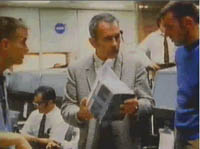
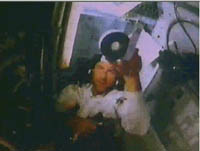
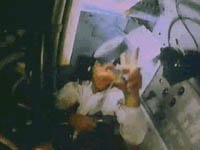

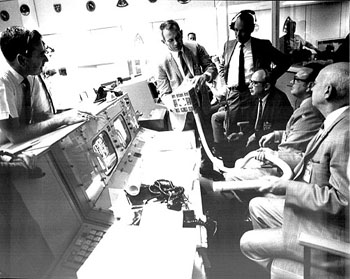
There was, of course, a fix; and it came in the form of an ingenious combination of suit hoses, cardboard, plastic stowage bags, and CSM canisters - all held together with a liberal application of gray duct tape. As was usual whenever the Apollo team had to improvise, engineers and astronauts on the ground got busy devising ways around the problem and then checked out the new procedures. A day and a half after the Apollo 13 accident, the ground teams had designed and built a filtering device that worked to their satisfaction. They promptly radioed instructions to the crew, carefully leading them through about an hour's worth of steps. As Lovell wrote later: "the contraption wasn't very handsome, but it worked." And that was all that mattered." - Eric Jones, Apollo Lunar Surface Journal (used by permission)
 Apollo 17 Lunar Dust Problem Fixed with Duct Tape
Apollo 17 Lunar Dust Problem Fixed with Duct Tape
On the Moon, the long history of micrometeorite bombardment has blasted away at the rocky surface creating a layer of powdery lunar soil or regolith. This lunar regolith could be a scientific and industrial bonanza. But for the Apollo astronauts and their equipment, the pervasive, fine, gritty dust was definitely a problem. On the lunar surface in December 1972, Apollo 17 astronauts Harrison Schmitt and Eugene Cernan needed to repair one of their lunar rover's fenders in an effort to keep the "rooster tails" of dust away from themselves and their gear. This picture reveals the wheel and fender of their dust covered rover along with the ingenious application of spare maps, clamps, and a grey strip of "duct tape". (NASA Photo
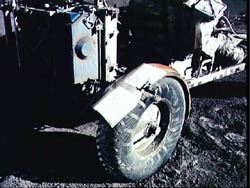
By MARCIA DUNN / AP Aerospace Writer (Published Sunday, May 13, 2001 - edited for length)
CAPE CANAVERAL, Fla. (AP) -- Astronaut Bill Shepherd was stunned -- and frustrated -- when he moved into the international space station last fall and discovered the kitchen table would not be arriving any time soon.
Shepherd did what any self-respecting home mechanic would do. He built his own table, out of space station scraps. The home improvement project, however, turned into as stealth an operation as Shepherd had ever tackled as a Navy SEAL.
One month into their 4 1/2 -month mission, Shepherd and cosmonauts Yuri Gidzenko and Sergei Krikalev began building the table out of aluminum frames that had held solid-fuel oxygen generators, as well as struts and pieces of angled aluminum. The men drilled holes, bolted the pieces together, covered the top with duct tape and, after weeks of working on it a bit at a time, finally had a table on which to eat, cook and work.
"Once we got it put together and finished, it was kind of the social center of the station, " Shepherd said. " That' s important, too."
Duct Tape: NASA approved restraint device
NASA has a detailed set of written procedures for dealing with a suicidal or psychotic astronaut in space. The
documents say the astronaut's crewmates should bind his/her wrists and ankles with duct tape, tie him/her down with a bungee cord and inject him/her with tranquilizers as necessary. - based on an Associated Press report - 2/23/07
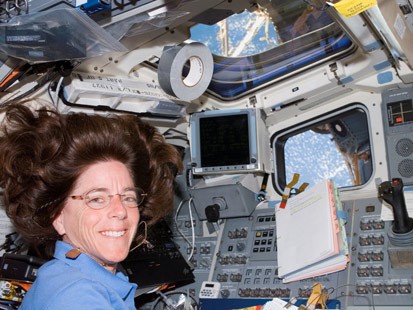
More evidence that duct tape goes up on every flight
This photo provided by NASA shows astronaut Barbara R. Morgan on the aft flight deck of the space shuttle Endeavor while docked with the international space station Sunday Aug. 12, 2007. Officials said they are more optimistic about the crew's safety following the discovery of foam that broke off and penetrated the shuttle. (NASA photo) We fully expect that a space walk with duct tape in hand will be used to fix the hole left from the broken foam.